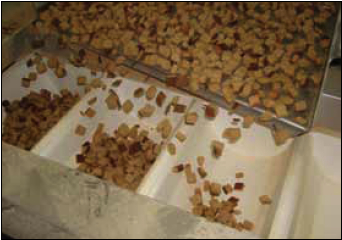|
|
Introduction
Beginning with founder Barney Kroger’s decision to be the first U.S. grocer to incorporate bakery goods manufacturing, The Kroger Company has maintained a tradition of exploring alternative solutions to increase operational efficiency, performance and reduce cost. Recently, The Kroger Company’s Indianapolis bakery identified the use of compressed air in a blow-off and conveyor gap transfer as a major source of energy loss and cost waste. According to the U.S. Department of Energy, “inappropriate use” of compressed air like blow-off produces high pressure atmosphere bleed leading to significant energy loss and unnecessary operational costs. Carrying a 10-15% efficiency return (according to the Department of Energy), compressed air applications can often be achieved more effectively, efficiently and less expensively with alternative solutions using a high flow rate and moderate pressure. Looking for alternative solutions for their blow-off and gap transfer applications, The Kroger Company contacted JetAir Technologies. JetAir Technologies’ resulting custom, high-speed, centrifugal motor and blower system offered The Kroger Company a 93% true energy power and cost savings with an impressive payback of only 2.7 months.
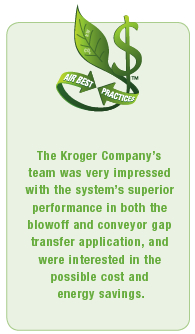 |
Problem
In an effort to optimize operational efficiency, The Kroger Company’s Indianapolis bakery conducted an energy usage and cost audit of their bread manufacturing systems. The Kroger Company’s evaluation identified the use of compressed air in a pre-slicing application and a pre-packaging application as two sources of significant energy loss and operational cost. The Kroger Company was generating 90 PSI of compressed air for a needed 1.75-2 PSI at the application sites. At the first application site, the compressed air was directed through a single ¼” copper nozzle mounted above the conveyor. This application provided gap transfer assistance of the loaves from the baking conveyor to the slicing conveyor. At the second application site, the compressed air was directed through a ¼” copper pipe drilled with 7 holes and mounted above and across the width of the conveyor. This second application provided loaf-top crumb blow-off between the loaf slicer and packaging system. Both applications were replicated on four manufacturing lines (a total of 8 applications).
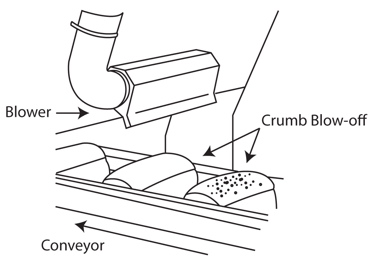
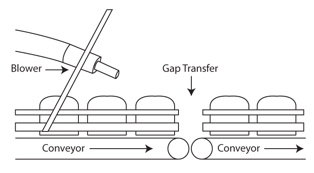

At each nozzle, the flow was measured at 70 CFM bringing the flow measurement for the entire system to 560 CFM. Assuming a rate of 4.4 CFM per kW, the eight applications were requiring a total of 171 HP or 127.3 kW of energy generation. With an operating schedule of 24 hours a day, 5 days a week, 52 weeks a year, the annual energy usage totaled to 794,182 kWh. Assuming a rate of \$0.07 kWh, the eight applications were costing The Kroger Company \$63,376 annually in energy and maintenance costs.
At The Kroger Company’s Indianapolis bakery, JetAir Technologies’ applications engineers set up a high-speed, centrifugal blower and air knife test system to demonstrate its operational efficiency, energy savings, and quality performance. The Kroger Company’s team was highly impressed with the system’s superior performance in both the blow-off and conveyor gap transfer application, and were interested in the possible cost and energy savings.
Solution
|
|
Returning to the applications lab, the JetAir Technologies’ engineering team designed a custom solution driven by the JET-2TM high-speed motor and blower fitted with Variable Frequency Drive (VFD) technology and a user-friendly HIM – Powerflex 70/700 keypad. Replacing the copper tubing at the 4 blow-off applications, JetAir Technologies mounted MXTM air knives (via adjustable mounts) above the conveyor and connected by 3” (75mm) diameter flexible hoses. Replacing the copper nozzles at the 4 conveyor transfer points, JetAir Technologies mounted 2” diameter JetBlast air nozzles (via adjustable mounts) above the conveyor at the transfer point and connected by 2” (50mm) diameter flexible hoses.

Testing of the custom solution demonstrated significant energy and operational savings. The Kroger Company’s original system consumed 171 HP (127.3 kW). JetAir Technologies’ custom JET-2TM system, on the other hand, enabled a 93% reduction in true energy consumption registering at 12 HP (9 kW) or a reduction of 159 HP. Based upon The Kroger Company’s production cycle (24 hours/day, 5 days/week, 52 weeks/year) and 127.3 kW per hour rate, JetAir Technologies estimated the JET-2TM custom solution’s energy cost as \$4,362 annually (including maintenance). The Kroger Company’s annual cost savings was an impressive \$59,014 per year, or annual 93%! Thanks to these energy and cost savings, The Kroger Company recognized 100% return on their investment in only 2.7 months.
Results
After installation, The Kroger Company was pleased regarding the system’s effective performance, energy efficiency, and the resulting return on investment.

Substituting a highly effective alternative solution like centrifugal blowers for the “inappropriate use of compressed air” (as defined by the DOE’s Compressed Air Challenge), The Kroger Company was able to reduce the amount of compressed air bled to the atmosphere and increase their cost savings. By employing high-speed, centrifugal blowers as an alternative solution for their blow-off and gap transfer, The Kroger Company was able to lower their monthly energy costs from \$5,281/mo to \$364/mo. This energy and cost savings totaled to a monthly energy savings of \$4,917, a 93% reduction of monthly cost.
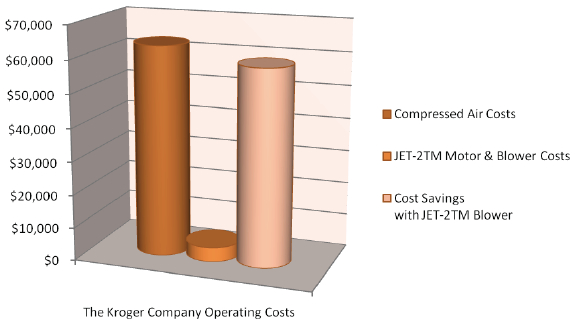
Operating Cost Savings with JET-2TM Blower and MXTM Air Knife
Focusing on innovation as a method of operation and profit optimization, The Kroger Company has continued to dominate as one of the top grocery retailers. In this age of rising energy costs and environmental impact concerns, manufacturers would be wise to follow suit. With compressed air utilized by 70% of U.S. manufacturers and representing 10% of all electricity usage (according to the Department of Energy), optimizing use and exploring innovative alternatives offers profit maximization opportunities. Emerging, energy-efficient technology like high-speed, centrifugal blowers offer an effective, environmentally-conscious alternative to compressed air that translates to bottom-line energy and cost savings.
For more information please contact Brendan Smith, JetAir Technologies LLC., tel: 805-654-7000 Main, email: brendan.smith@jetairtech.com, www.jetairtech.com.


